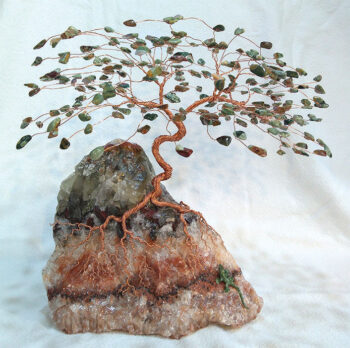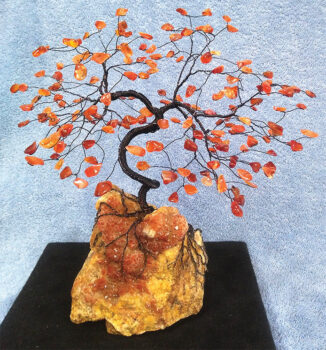
Pink Botswana agate on rose quartz

Rainforest rhyolite on acid-washed banded agate

Carnelian on spessartine garnet
Suzanne Close
Join the club and make a Ming tree. I can’t recall the first Ming tree I ever saw, perhaps because it was 18 years ago, soon after we bought our Sun Lakes house and joined the Sun Lakes Rock, Gem & Silver Club (SLRGS). I recall my first impression though—I thought they were gorgeous.
I have participated in many of the club’s activities over the years. Making Ming trees has become one of my favorite disciplines. Until I began teaching “How to Make Ming Trees” in early 2019, it had been some 10 or 15 years since there had been another qualified Ming tree instructor willing and able to instruct. The art of making the SLRGS Ming trees was in danger of becoming extinct. I was encouraged to teach how to make them, yet I was not properly qualified. However, the idea of teaching how to make them intrigued me. It was the perfect way for me to give back. I could make beautiful Ming trees and teach others how to do it, too.
As luck would have it, our then president, Carol Capano, had learned how to make Ming trees some 20 years ago from a gentleman called Henry Grimmet, who many considered an expert at making Ming trees. His trees were spectacular, as are Carol’s trees. So, Carol taught me how to make them. We got together weekly, spending a full afternoon for several months, until she felt I was sufficiently qualified to teach others how to make them. With proven skills, I presented myself as an instructor to the board of directors, submitted a proposal, and voilà. The rest is history.
Ming trees are not commonly found. Sure, you can find cheap, Chinese-made, cookie-cutter trees, more commonly called “gem trees,” but they are mass produced and generally crude and small, not nearly of the same quality as our trees, which are artistic and original. Speed is obviously not a factor when making our trees.
There are numerous benefits to making a Ming tree. You do not need to go to the shop—you can do it at home, although our classes are held at the Cottonwood shop. It does not take a long time to make one—five or six weeks for three hours is enough time to complete a medium-size tree. A rock, wire, gemstones, cement, and glue is basically all you need to make a tree. There are tips and tricks that help, of course, if you want to call elastic bands and a bottle of wine required matter.
Bottle of wine? you ask. Actually, just the cork—best to save the wine for later. Some rocks do not require cork or foam, although some, by the very nature of their design, are tricky to work with, so a cork or stiff foam works well to secure the roots to the rock, along with elastic bands, until the cement dries.
Making these trees is totally enjoyable, and you end up with a beautiful tree to display in your home or to offer as a gift to someone you love. The class is $50, and that includes everything you will need to make one medium-size tree. Classes are held usually in the spring, summer, and fall on Saturday afternoons. Contact Suzanne Close at suzan907@gmail.com to sign up—put “SLRGS Ming Trees” in the subject matter. Masks are mandatory, and we can social distance in class.
